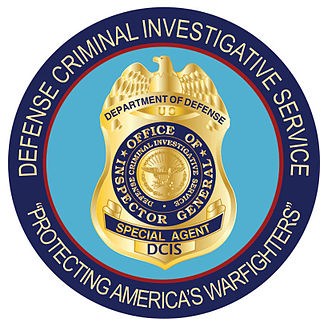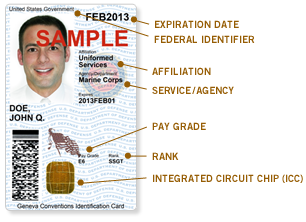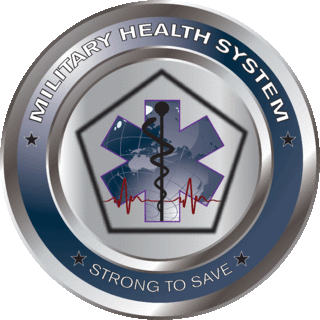Related Research Articles

The Defense Commissary Agency (DeCA), headquartered at Fort Gregg-Adams, Virginia, is an agency of the United States Department of Defense (DoD) that operates nearly 240 commissaries worldwide. American military commissaries sell groceries and household goods to active-duty, Guard, Reserve, and retired members of all eight uniformed services of the United States and eligible members of their families at cost plus surcharge, saving authorized patrons thousands of dollars compared to civilian supermarkets.
A national identification number, national identity number, or national insurance number or JMBG/EMBG is used by the governments of many countries as a means of tracking their citizens, permanent residents, and temporary residents for the purposes of work, taxation, government benefits, health care, and other governmentally-related functions.

The Defense Criminal Investigative Service (DCIS) is the criminal investigative arm of the Office of Inspector General, U.S. Department of Defense. DCIS protects military personnel by investigating cases of fraud, bribery, and corruption; preventing the illegal transfer of sensitive defense technologies to proscribed nations and criminal elements; investigating companies that use defective, substandard, or counterfeit parts in weapon systems and equipment utilized by the military; and stopping cyber crimes and computer intrusions.
An exchange is a type of retail store found on United States military installations worldwide. Originally akin to trading posts, they now resemble contemporary department stores or strip malls. Exact terminology varies by armed service; some examples include base exchange (BX), and post exchange (PX), and there are more specific terms for subtypes of exchange.

The Common Access Card, also commonly referred to as the CAC, is the standard identification for Active Duty United States Defense personnel. The card itself is a smart card about the size of a credit card. Defense personnel that use the CAC include the Selected Reserve and National Guard, United States Department of Defense (DoD) civilian employees, United States Coast Guard (USCG) civilian employees and eligible DoD and USCG contractor personnel. It is also the principal card used to enable physical access to buildings and controlled spaces, and it provides access to defense computer networks and systems. It also serves as an identification card under the Geneva Conventions. In combination with a personal identification number, a CAC satisfies the requirement for two-factor authentication: something the user knows combined with something the user has. The CAC also satisfies the requirements for digital signature and data encryption technologies: authentication, integrity and non-repudiation.

Tricare is a health care program of the United States Department of Defense Military Health System. Tricare provides civilian health benefits for U.S Armed Forces military personnel, military retirees, and their dependents, including some members of the Reserve Component. Tricare is the civilian care component of the Military Health System, although historically it also included health care delivered in military medical treatment facilities. Tricare functions similar to a single-payer healthcare system.

The Defense Manpower Data Center (DMDC) serves under the Office of the Secretary of Defense to collate personnel, manpower, training, financial, and other data for the Department of Defense. This data catalogues the history of personnel in the military and their family for purposes of healthcare, retirement funding and other administrative needs. It has offices in Seaside, California and Alexandria, Virginia.

A United States Uniformed Services Privilege and Identification Card is an identity document issued by the United States Department of Defense to identify a person as a member of the Armed Forces or a member's dependent, such as a child or spouse.
TriWest Healthcare Alliance is a Phoenix, Arizona based corporation that manages health benefits under the United States Department of Veterans Affairs (VA) VAPCCC program in Regions 3, 5, and 6. On October 1, 2018, TriWest's contract for VAPCCC was expanded to cover Regions 1, 2, and 4.
The Extended Care Health Option or ECHO is a supplemental coverage program offered by TRICARE to dependents of members of the uniformed services of the United States with a qualifying disability.
The Real-Time Automated Personnel Identification System (RAPIDS) is a United States Department of Defense (DoD) system used to issue the definitive credential within DoD. RAPIDS uses information stored in the DoD Defense Enrollment Eligibility Reporting System (DEERS) when providing these credentials. Used together, these two systems are commonly referred to as a DEERS/RAPIDS system or DEERS/RAPIDS infrastructure.
Military psychiatry covers special aspects of psychiatry and mental disorders within the military context. The aim of military psychiatry is to keep as many serving personnel as possible fit for duty and to treat those disabled by psychiatric conditions. Military psychiatry encompasses counseling individuals and families on a variety of life issues, often from the standpoint of life strategy counseling, as well as counseling for mental health issues, substance abuse prevention and substance abuse treatment; and where called for, medical treatment for biologically based mental illness, among other elements.
The President's Commission on Care for America's Returning Wounded Warriors, also known as the Dole-Shalala Commission, was established on March 6, 2007, when U.S. President George W. Bush signed Executive Order 13426. The Commission was established to examine and recommend improvements to the effectiveness and quality of transition from returning to military service or civilian society, health care, benefits, outreach to service members, and awareness among service members of healthcare and benefits programs.

The Military Health System (MHS) is a form of nationalized health care operated within the United States Department of Defense that provides health care to active duty, Reserve component and retired U.S. Military personnel and their dependents.
The Uniformed Services Benefit Association (USBA) is a nonprofit organization headquartered in Overland Park, Kansas, providing affordable group life insurance plans and other financial services specifically designed for active duty and retired military members and their families, as well as honorably discharged veterans, National Guard and Reserve members, and federal civilian employees.
AHLTA is a global Electronic Health Record (EHR) system used by U.S. Department of Defense (DoD). It was implemented at Army, Navy and Air Force Military Treatment Facilities (MTF) around the world between January 2003 and January 2006. It is a services-wide medical and dental information management system. What made AHLTA unique was its implementation date, its Central Data Repository, its use in operational medicine and its global implementation. There is nothing like it in the private sector.

The Veteran Health Identification Card (VHIC) is an identification card issued by the United States Department of Veterans Affairs (VA) for eligible veterans to receive medical care at VA Medical Facilities. The VHIC protects the privacy of veterans' sensitive information, as it no longer displays the Social Security number or date of birth on the front of the card. The VHIC will only display the veteran's name, picture, and special eligibility indicators—Service Connected, Purple Heart and former POW, if applicable, on the front of the card. Only veterans who are eligible for VA medical benefits will receive the card. Starting on Jan. 1, 2020, the Purple Heart and Disabled Veterans Equal Access Act allows Purple Heart recipients, former prisoners of war and veterans with service-connected disabilities entry onto military installations to use the AAFES Exchange; commissary and Morale, Welfare and Recreation facilities.
The Federal Data Services Hub is a tool used to facilitate the government-backed Patient Protection and Affordable Care Act health coverage program.
The Transition Assistance Program (TAP) is a U.S. Department of Defense (DoD) led program that provides information and training to ensure service members transitioning from active-duty are prepared for their next step in life - whether pursuing additional education, finding a job in the public or private sector, or starting their own business.
VetVerify.org is a shared online service of the Army & Air Force Exchange Service, the Navy Exchange Service Command, the Marine Corps Exchange and the Coast Guard Exchange. Its sole purpose is to verify eligibility for the veterans online shopping benefit, a 2017 expansion of online military exchange shopping privileges to honorably discharged Veterans.
References
- ↑ "Department of Defense Extends Online Military Exchange Shopping Privileges to Veterans". U.S. Department of Defense (DoD). January 13, 2017. Retrieved 16 August 2017.
- ↑ "Veterans Online Shopping Benefit". VetVerify.org. 2017. Retrieved 16 August 2017.
- ↑ "Updating Defense Enrollment Eligibility Reporting System". U.S. Department of Defense. Retrieved 2023-10-05.
- ↑ Gallagher, Deb (14 December 2004). "Unique Identification Joint Requirements Implementation Board: People UID". Defense Manpower Data Center Access Card Office. p. 3. Retrieved 15 January 2021.